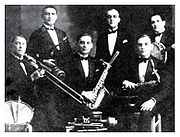
Artur Gold
Encyclopedia

Violin
The violin is a string instrument, usually with four strings tuned in perfect fifths. It is the smallest, highest-pitched member of the violin family of string instruments, which includes the viola and cello....
ist and dance-music composer
Composer
A composer is a person who creates music, either by musical notation or oral tradition, for interpretation and performance, or through direct manipulation of sonic material through electronic media...
. He was the second son of Michał Gold, a musician in the Warsaw Opera; when Michał died an uncle took him to England, where he received his musical education. He later returned to Warsaw and played there in various nightclubs. His closest collaborators were his brother Henryk
Henryk Gold
Henryk Gold was a Polish Jewish composer, arranger, and orchestra director born in Warsaw to a musical family...
and Jerzy Petersburski
Jerzy Petersburski
Jerzy Petersburski was a Polish pianist and composer of popular music, renowned mostly for his Tangos, some of which were milestones in popularization of the musical genre in Poland and are still widely known today, more than half a century after their creation.Jerzy Petersburski was born April...
, with whom he arranged for his famous ensembles; they were among the most popular composers in interwar Poland and their many hits were sung through the whole country. Gold ran an orchestra in the Qui Pro Quo theater (1922) and in the Warsaw cabaret Adria
Adria
Adria is a town and comune in the province of Rovigo in the Veneto region of Northern Italy, situated between the mouths of the rivers Adige and Po....
(1931–1939).
Some of his noted compositions were the foxtrot Gdy Petersburski razem z Goldem gra ("When Petersburski and Gold play together") (1926), the tango
Tango music
Tango is a style of ballroom dance music in 2/4 or 4/4 time that originated among European immigrant populations of Argentina and Uruguay . It is traditionally played by a sextet, known as the orquesta típica, which includes two violins, piano, double bass, and two bandoneons...
Gdy w ogrodzie botanicznym ("In the botanical garden"), Jesienne róże ("Autumn roses"), Nie odchodź ode mnie (Don't walk away from me), Nie wierzę ci, Jaśminy (Jasmine), Kwiaciarka z Barcelony (Flower girl from Barcelona), Oczy czarne (Black Eyes), Ostatni jeszcze, and others. Most of the texts were by Andrzej Włast
Andrzej Włast
Andrzej Włast was a Polish Jewish songwriter. He wrote the lyrics for the 1929 hit song "Tango Milonga". He died in the Warsaw Ghetto during World War II.-Biography:...
.
He also performed with English orchestras in the 1920s and recorded for Columbia records
Columbia Records
Columbia Records is an American record label, owned by Japan's Sony Music Entertainment, operating under the Columbia Music Group with Aware Records. It was founded in 1888, evolving from an earlier enterprise, the American Graphophone Company — successor to the Volta Graphophone Company...
. In the 1930's he also recorded several albums for the "Odeon" phonograph company.
During World War II
World War II
World War II, or the Second World War , was a global conflict lasting from 1939 to 1945, involving most of the world's nations—including all of the great powers—eventually forming two opposing military alliances: the Allies and the Axis...
, Artur played with an orchestra in the Warsaw Ghetto
Warsaw Ghetto
The Warsaw Ghetto was the largest of all Jewish Ghettos in Nazi-occupied Europe during World War II. It was established in the Polish capital between October and November 15, 1940, in the territory of General Government of the German-occupied Poland, with over 400,000 Jews from the vicinity...
. He was deported by the Germans from the Umschlagplatz to Treblinka extermination camp
Treblinka extermination camp
Treblinka was a Nazi extermination camp in occupied Poland during World War II near the village of Treblinka in the modern-day Masovian Voivodeship of Poland. The camp, which was constructed as part of Operation Reinhard, operated between and ,. During this time, approximately 850,000 men, women...
where he played for the Nazis in their casino and where he was murdered in 1943. According to recollections of some of the Treblinka survivors Gold might have been killed during the uprising at Treblinka which occurred on August 2, 1943.
The melody of his song Chodź na Pragę (Come to Praga) (1930) is currently played as a Hejnał of the Warsaw borough of Praga
Praga
Praga is a historical borough of Warsaw, the capital of Poland. It is located on the east bank of the river Vistula. First mentioned in 1432, until 1791 it formed a separate town with its own city charter.- History :...
, each day at noon.

